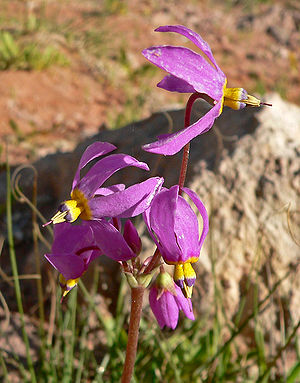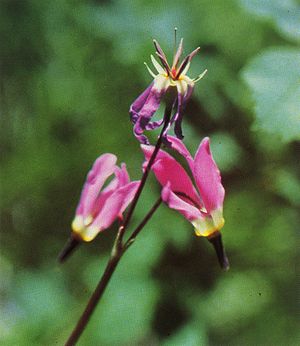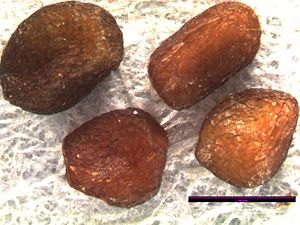Dodecatheon pulchellum
- Latin Name: Dodecatheon pulchellum
- Family: Primulaceae
- Common Names: darkthroat shooting star
- Synonyms/Misapplications: Exinia pulchella
- Codon: DODPUL
Contents
Taxonomy
- Kingdom Plantae – Plants
- Subkingdom Tracheobionta – Vascular plants
- Superdivision Spermatophyta – Seed plants
- Division Magnoliophyta – Flowering plants
- Class Magnoliopsida – Dicotyledons
- Subclass Dilleniidae
- Order Primulales
- Family Primulaceae – Primrose family
- Genus Dodecatheon L. – shootingstar
- Species Dodecatheon pulchellum (Raf.) Merr. – darkthroat shootingstar
Description
General: Scapose, perennial herbs from short rhizomes, glabrous to glandular-pubescent throughout, the flowering stems 5-40 cm. tall.
Leaves: Leaves basal, the blades oblong-lanceolate to oblanceolate, 2-15 cm. long, entire to denticulate, narrowed gradually to winged petioles nearly as long.
Flowers: Flowers 1-25 in an umbel, terminal on the scape, 5-parted; calyx purple-flecked, the lobes 3-5 mm. long; corolla 10-20 mm. long, the lobes purplish-lavender, the tube yellowish with a purple line at the base; stamens clustered around the style, opposite the petals, the filaments united in a yellow, orange or purple tube 1.5-3 mm. long; anthers yellowish to reddish-purple, 4-7 mm. long; style single, barely exceeding the stamens, the stigma slightly enlarged
Fruit: Capsule ovoid-cylindric, 5-15 mm. long, glabrous to glandular hairy, opening by valves to the tip.
Bloom Period
Late Spring
Distribution
Alaska to Mexico, east to Pennsylvania; found throughout the Pacific Northwest. It ranges from Alaska to Manitoba south to California, Colorado, Nebraska, and Arizona.
Habitat
Dodecatheon pulchellum occurs in perennially moist to wet soils of meadows and along streams from mid elevations in the mountains to the alpine. Its ecological setting ranges from Coastal prairies to inland saline swamps and shrub-steppe, sea level to timberline.
Uses
Low palatability for browsing and grazing animals.
Propagation
Citations: Evans, Jeff; Hosokawa, Joy.; Wick, Dale. 2008. Propagation protocol for production of container Dodecatheon pulchellum (Raf.) Merr. plants (172 ml containers); USDI NPS - Glacier National Park, West Glacier, Montana. In: Native Plant Network. URL: http://www.nativeplantnetwork.org (accessed 8 March 2010). Moscow (ID): University of Idaho, College of Natural Resources, Forest Research Nursery Skinner, David M. 2006. Propagation protocol for production of container Dodecatheon pulchellum (Raf.) Merr. plants (10 cu. in.); USDA NRCS - Pullman Plant Materials Center, Pullman, Washington. In: Native Plant Network. URL: http://www.nativeplantnetwork.org (accessed 8 March 2010). Moscow (ID): University of Idaho, College of Natural Resources, Forest Research Nursery.
Seed Storage Storage Requirements: Refrigerator. Seed Storage Longevity: Germination: 65% (Evans, Hosokawa & Wick).
Clean seed is stored at 40 degrees Fahrenheit and 40% relative humidity (Skinner).
Nursery Conditions Infrastructure Requirements: Outdoor nursery growing facility. Nutrition Program: Pest Control Practices: Special Growing Medium Requirements: Growing medium used is 6:1:1 milled spaghnum peat, perlite, and vermiculite with Osmocote controlled release fertilizer (13N:13P2O5:13K2O; 8 to 9 month release rate at 21C) and Micromax fertilizer (12%S, 0.1%B, 0.5%Cu, 12%Fe, 2.5%Mn, 0.05%Mo, 1%Zn) at the rate of 1 gram of Osmocote and 0.20 gram of Micromax per 172 ml container (Evans, Hosokawa & Wick). Cross-Pollination Concerns: Time to Grow: 8 months (Evans, Hosokawa & Wick). 3 years (Skinner). Timeline: Sow Nov,Germinate May, Harvest July (Evans et al).
Production Phase 1- Fruit/Seed Dormancy and Pre-Treatment Length of Dormancy: Type of dormancy: Physiological dormancy (Evans, Hosokawa & Wick) Pretreatment Type: Outdoor cold, moist stratification (Evans, Hosokawa & Wick). Pretreatment Length: 5 months (Evans, Hosokawa & Wick)
Extended cold, moist stratification is needed. Cool spring temperatures may also be necessary. In trials at the PMC, no germination occurred without stratification and no seed germinated after 30 days cold, moist stratification. Seed planted in containers in November and left outside began emerging in late March and reached 65% by late April. Seed of Dodecatheon meadia requires 2 months of cool, moist stratification (Greene & Curtis 1950) (Skinner).
Production Phase 2- Sowing and Germination Sowing Methodologies: In early November seed is sown in 10 cu. in. Ray Leach Super cells filled with Sunshine #4 and covered lightly. A thin layer of pea gravel is applied to prevent seeds from floating. Containers are watered deeply and placed outside (Skinner). Containers are filled and sown in late fall and irrigated thoroughly prior to winter stratification (Evans et al).
Recommended Sow Rate: Germination Length:(time from sowing to emergence of radicle)
Production Phase 3- Establishment Establishment Methodology: Containers remain outside. They are watered only during dry spells. Plants begin emerging in late March. Germination occurs over a 3-4 week period (Skinner). Seedlings germinate in spring under fluctuating outdoor temperatures and are grown under full sun exposure. Seedlings are irrigated with Rainbird automatic irrigation system in early morning until containers are thoroughly leached. Germination occurs at fluctuating temperatures during May. Medium is kept slightly moist during germination. (Evans et al). Establishment Length: 4 weeks (Skinner) (Evans et al).
Production Phase 4-Active Growth Active Growth Methodology: Plants are watered as needed while outside and fertilized once a week with a water soluble, complete fertilizer. They are moved to the lath house in June. The plants develop small rosettes with several true leaves. They will not go dormant with summer temperatures but cease growing (Skinner). Root and shoot development occurs rapidly following germination. 4 to 6 true leaves were evident 3 weeks after germination. Seedlings were root tight 4 weeks after germination (Evans et al). Active Growth Length: 2 months (Skinner). 12 weeks (Evans et al).
Production Phase 5- Finishing Finishing/Hardening Methodology: Fertilizer is withheld in September and water decreased to harden the plants for winter. Since the plants are grown outside, additional hardening is not needed (Skinner). Plants are fertilized with 10-20-20 liquid NPK at 200 ppm during August and September. Irrigation is gradually reduced in September and October. Plants were given one final irrigation prior to winterization (Evans et al). Finishing/Hardening Length: 4 weeks (Evans et al). Overwinter live plant storage: Overwinter in outdoor nursery under insulating foam cover and snow (Evans et al). Plants are stored in the lath house over winter. They should be afforded some protection from extreme cold temperatures. Mulch or foam sheets provide sufficient protection. The protection should be removed in late winter or early spring as temperatures begin to rise (Skinner).
Production Phase 6- Outplanting Indications: Because the plants begin growing early in the spring, late fall outplanting is preferred where soils are generally too muddy in February and early March. However, the tapered plug from the container has a tendency to frost heave and leave the upper part of the plug exposed. Fall transplants should be checked in early spring and exposure of the plug corrected. Transplanting is done in late October by using an electric drill and portable generator to drill 1.5 inch diameter holes at the planting site. Survival in a seed increase planting without competing vegetation was 60%. A few plants flowered the following spring (Skinner).
Additional Comments: Dodecatheon species, such as D. jeffreyi, D. conjugens, D. pulchellum are reported to germinate best when subjected to a cold, moist stratification for at least 90 days (Evans et al). Plants should not be dug up from stands in the wild. Wild grown plants rarely survive the transplanting process (Parish 1996, Kruckeberg 1996).
Seed
Abbreviation: DOPU
Seed sample from: 2010
Average Measurement: 1.1 x 0.8 x 0.8
Measurement Range: L: 1 – 1.3, W: 0.5 – 1, D: 0.4 -1
Features
Shape: Seeds generally somewhat cubic in shape, but very irregularly angular and sometimes pitted. Hilium is very difficult to identify. It may be a small scratch-like scar appearing white in color.
Color: Seeds brown, somewhat glossy, and has a net veined pattern of ridges.
Latitudinal Cross Section: irregularly angular
Longitudinal Cross Section: irregularly angular
References
- Dodecatheon pulchellum subsp. pulchellum - Wikimedia Commons. Dodecatheon pulchellum subsp. pulchellum in Calico Basin, west of Las Vegas, Nevada - Stan Shebs (This file is licensed under the Creative Commons Attribution-Share Alike 3.0 Unported license. Attribution: Stan Shebs)
[1]. Retrieved 05/07/2012.
- USDA, NRCS. 2012. Dodecatheon pulchellum (Raf.) Merr. USDA PLANTS Profile, PLANTS Database (http://plants.usda.gov/java/profile?symbol=dopu, 7 May 2012). National Plant Data Team, Greensboro, NC 27401-4901 USA. Retrieved 04/13/2012.
Image Gallery
<gallery> Image:Dodecatheon pulchellum ssp pulchellum 2.jpg Image:dopu_001_pvp.jpg File:Dodecatheon pulchellum.jpg File:Dopu 018 lvp.jpg



